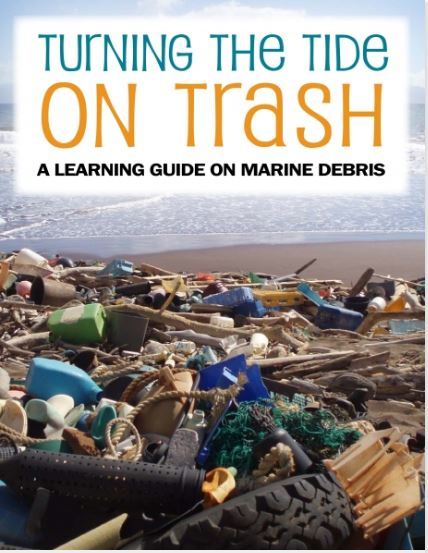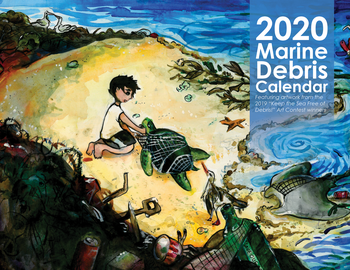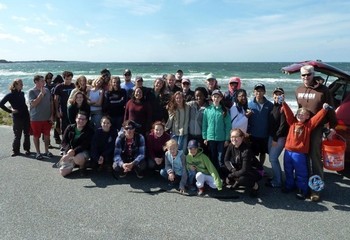 Access educational resources on the NOAA Marine Debris Program website.
Each year, the International Coastal Cleanup (ICC) hosts a worldwide cleanup event involving around 1 million volunteers. As the ICC determines the total amount of items collected, they compile a "top ten" list in their annual Cleanup Report. The "Marine Debris - Data Mining" lesson (page 30) is designed to increase students' awareness of the different kinds of debris in water environments, and the impact they have on animals, humans, and aquatic habitats. Bonus - students work with real, ICC data! Download the lesson plan here.
 The 2020 calendar cover was created by Jennie C., grade 8, from Massachusetts.
The NOAA Marine Debris Program is proud to announce that our 2020 Marine Debris Calendar is now available for download!
This year’s calendar features artwork from thirteen students in first through eighth grade, all winners of the “Keep the Sea Free of Debris” art contest. Our annual art contest aims to get students thinking about how marine debris impacts our ocean and Great Lakes, and what they can do to help!
Visit our website to view the winning entries, download the 2020 Marine Debris Calendar, and find information on how to request a hard copy.
 Enter the art contest for the 2021 calendar!
Are you a student or teacher that’s passionate about marine debris? Then get your art supplies ready, because this year’s NOAA Marine Debris Program Art Contest is officially open! Students in grades K-8 from the United States and U.S. territories can submit their artwork now through November 30th.
For a complete list of contest rules, visit our website and download the student entry form and art contest flyer.
 Submit a Letter of Intent by November 5, 2019 (Photo: Monterey Bay Aquarium).
The NOAA Marine Debris Program is proud to announce our FY 2020 “Marine Debris Prevention” federal funding opportunity.
This opportunity provides funding for projects that actively engage and educate a target audience (such as students, teachers, industries, or the public) in hands-on programs designed to raise awareness, provide practical approaches, reduce barriers, and encourage and support changes in behaviors to ensure long-term prevention of marine debris.
Learn More
 As part of the project, students organized and participated in beach cleanups that raised marine debris awareness (Photo: Erin Bryant, Sea Education Association).
Sea Education Association teamed up with the Falmouth Water Stewards and the NOAA Marine Debris Program and reduced the use of single-use plastic items by engaging students in lessons on marine debris, social science research, and the creation of a local campaign to educate the community and promote behavior change.
Learn More
Download the "Trash Shouldn't Splash" Curriculum
Turn a 2- Liter bottle into a STEM project by creating personal classroom greenhouse.
Supplies needed:
-2- Liter bottle with label removed *enough for each student
-Pebbles/gravel
-Potting soil
-Seeds
-Or pre-sprouted plants such as a fern or succulent
Directions:
1. About 4-5 inches from the bottom of the bottle, cut halfway around the base. The bottle now has a "top" and "bottom" section. The bottom section will hold the pebbles, soil, seed or plant; the top section will be the cover of the greenhouse (see pictures above).
2. Fill a thin layer of pebbles in the bottom section of the bottle. Next, add potting soil until it just reaches the top edge of the container. Plant the seeds following the directions on the package or dig a small hole in the soil to plant your fern, succulent, etc. Gently pat the soil in place and lightly water.
3. Using the top section, cut a small slit, about 1 inch high, from the bottom edge. Next, place the top section over the bottom section allowing the 1 inch slit to fit tightly around the bottom section. Note: You may need to gently squeeze the bottom section to help the top section fit securely together.
4. Place the plants in a sunny area and water as needed. Measure and record the growth of the plants.
Tip: Write the student's name on the outside of the bottle. To turn the greenhouse into a habitat, either place small toy animals inside the greenhouse or stick plant/animal stickers on the outside of the bottle.
Let us know what you think!
Please provide feedback on our marine debris resources so that we can better serve your needs.
Email: marinedebris.education@noaa.gov
|